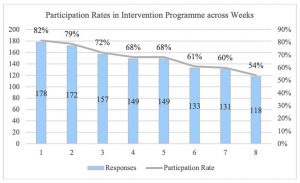Mindfulness Training Increases the Use of Yoga and Meditation to Cope with the Covid-19 Lockdown
By John M. de Castro, Ph.D.
“mindfulness is one tool that can help promote mental wellness throughout the COVID-19 pandemic and beyond.” – Julie Dunne
Mindfulness training has been shown to improve health and well-being in healthy individuals. It has also been found to be effective for a large array of medical and psychiatric conditions, either stand-alone or in combination with more traditional therapies. The COVID-19 pandemic has challenged the mental and physical health of the population. It has created intense stress both for frontline workers but also for people simply isolating at home. Mindfulness is known to decrease the psychological and physical responses to stress. So, mindfulness training may be helpful in coping with the mental and physical challenges resulting from the lockdown during the the COVID-19 pandemic.
In today’s Research News article “Developing Resilience During the COVID-19 Pandemic: Yoga and Mindfulness for the Well-Being of Student Musicians in Spain.” (See summary below or view the full text of the study at: (https://www.frontiersin.org/articles/10.3389/fpsyg.2021.642992/full?utm_source=F-AAE&utm_medium=EMLF&utm_campaign=MRK_1616048_69_Psycho_20210504_arts_A ) Bartos and colleagues recruited Spanish college music students who enrolled in 1-hour per week mindfulness course and those who did not. The course ran from November 2019 to May 2020. In march 2020 a nationwide lockdown was initiated and the mindfulness course switched to online. The students were asked whether during Covid-19 lockdown they received psychological help, had setbacks, health changes, the nature of health changes, changes in physical, psychological, and sleep quality during the lockdown, and any practices engaged in during the lockdown and the nature of the practices.
They found that the students who experienced mindfulness training were significantly more likely to practice yoga and meditation to improve their health and well-being during the lockdown than the control participants. They also indicated that they received greater benefits from the practices. Almost all of the mindfulness trained participants engaged in these practices while only about a half of the control participants did.
It should be noted that there wasn’t random assignment of students to groups. Rather, the groups were formed by the selections of the students. This can result in different kinds of students in the two groups. It is possible that students who were likely to use yoga and meditation as coping mechanisms would be much more likely to choose to participate in a mindfulness course.
The Covid-19 lockdown provided a natural experiment that the researchers took advantage of to investigate the impact of mindfulness training on the students’ well-being during the lockdown. The findings support the efficacy of mindfulness training in improving the likelihood that yoga and meditation will be used as coping strategies and that these practices produce greater perceived benefits.
So, mindfulness training increases the use of yoga and meditation to cope with the covid-19 lockdown.
“Introducing a mindfulness and meditation practice during this pandemic has the potential to complement treatment and is a low-cost beneficial method of providing support with anxiety for all.” – C. Behan
CMCS – Center for Mindfulness and Contemplative Studies
This and other Contemplative Studies posts are also available on Google+ https://plus.google.com/106784388191201299496/posts and on Twitter @MindfulResearch
Study Summary
Bartos LJ, Funes MJ, Ouellet M, Posadas MP and Krägeloh C (2021) Developing Resilience During the COVID-19 Pandemic: Yoga and Mindfulness for the Well-Being of Student Musicians in Spain. Front. Psychol. 12:642992. doi: 10.3389/fpsyg.2021.642992
Here, we report on a quasi-experimental study to explore the applicability and perceived benefits of the CRAFT program, which is based on mindfulness, yoga, positive psychology, and emotional intelligence, to improve higher education student musicians’ health and well-being during the lockdown. A subset of student musicians at a Higher Conservatory of Music in Spain followed the CRAFT program during the academic year 2019/2020, 1 h per week as part of their curriculum. Students enrolled in CRAFT-based elective subjects formed the CRAFT program group (n = 40), while other students represented the control group (n = 53). The onset of the national lockdown elicited by the COVID-19 pandemic occurred halfway through the program, which was subsequently delivered in an online format. We administered an online survey to explore the effect that the exposure to the CRAFT program had in terms of how participants dealt with various health and well-being concerns arising from the COVID-19 lockdown. There was a significantly higher proportion of proactive participants in the CRAFT program group, 92%, than in the control group, 58%, in terms of implementing practices to improve their health and well-being during the lockdown. Additionally, significantly more participants acknowledged perceived benefits from their practices in the CRAFT program group, 78%, than in the control group, 52%. Among proactive participants, yoga/meditation was the most implemented in the CRAFT program group, followed by exercise, and other yoga/meditation practices, whereas in the control group, exercise and Alexander technique-based practices were the most applied. In the CRAFT program group, the highest rate of perceived benefits was from yoga/meditation CRAFT-based practices, 51%, followed by exercise, 32%, and other yoga/meditation practices, 27%, whereas in the control group, benefits were reported by 29% of exercising participants and 16% for those having practiced the Alexander technique. A similar pattern was observed when excluding participants with previous yoga/meditation experience. This study revealed how participants can independently apply learned skills from the CRAFT program in response to a naturally occurring life event of unprecedented global impact, suggesting that previous exposure to mindfulness and yoga is likely to have a beneficial effect on how young adults react towards exceptionally stressful conditions.









